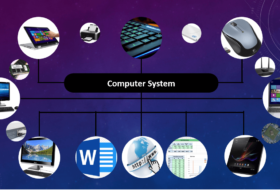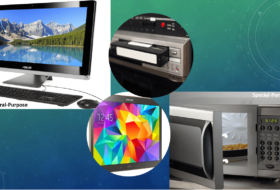Another way to classify a computer system is by size. Classification of computers by size is important to computer scientists and users.
Classification of computers by size allows us to group the computer system based on the physical magnitude and processing power.
Ordinary users see this classification to be more important because it reveals the magnitude and processing power of a computer. Computer scientists use this classification to know the capacity and usage of a given computer system.

Classification of a computer by size looks at the following:
- The physical size of a computer system
- The processing capacity and storage units
- The cost and usage
In this tutorial, we shall discuss the four main classes of computers by size, namely:
- Supercomputers
- Mainframe computers
- Minicomputers, and
- Microcomputers
Classification of computers by size
Supercomputers –
Supercomputers are the fastest and most expensive machines in the world. Unlike other computers, the speed of a supercomputer is measured in Floating-Point Operations Per Second (FLOPS).
| Characteristic | Description |
| Size | They are large |
| Cost | They are very expensive |
| Processing | They use parallel processing, vector, scalar, and multi-threaded processors |
| Speed | Floating-point per second (FLOPS) – Extremely fast |
| Usage | Tasking computations, e.g. weather forecasting, aircraft design |
| Apps | Linux OS (run different OS in different nodes) |
| Power | Consumes a lot of energy, e.g. Fugaku consumes 29,899kw of energy. |
| Examples | Cray-1, Tianhe-2A, HPC5, Frontera |
Normal computer speed is measured in Million Instructions Per Second (MIPS). One petaflop equals one thousand trillion flops, and a supercomputer with 1-petaflop can perform one quadrillion (1015) flops per second.
According to the Top500 list, the fastest supercomputer in the world is the Japanese Fugaku A64FX 48C. It has a world record of 7,630, 848 cores, which made it about 3x faster than IBM Summit. The fastest supercomputer in the world has a processing speed of 442 flop/s.
Supercomputers could use parallel processing, vector, scalar, or multi-threaded processors. (Parallel processing is a system that allows more than one processor to perform a single computation at the same time). They also consume a lot of energy and generate a lot of heat, hence requiring a cooling system. For example, IBM Summit consumes 10096KW of energy.
Supercomputers are specially built to handle highly difficult computations. This is why they are used in weather forecasting, climate research, molecular and biological research, nuclear research, and aircraft design. They can also be found in major universities, military agencies, and scientific research laboratories.
The first commercial supercomputer was CDC 6600, designed by Seymour Cray in the 1960s/70s. Other examples include IBM Sierra Nvidia/Mellanox, Sunway Taihulight, Nvidia Selene, etc.
Supercomputers run different operating systems in different nodes. Linux operating is predominantly used.
Mainframe Computers:
Mainframe computers are designed to be used as data servers for major corporations around the world. They have the highest level of security and can reliably perform trillions of interconnected transactions daily.
| Characteristic | Description |
| Size | Less in size than super but larger than minicomputer |
| Cost | Less expensive than a supercomputer |
| Processing | Use multiprocessors (up to 7 cores per CPU) |
| Speed | Trillion daily transactions |
| Usage | Bulky data processing, e.g. industry statistics, census |
| Apps | Linux OS (run different instances in virtual machines) |
| Power | Consumes less power than a supercomputer |
| Examples | IBM z14 – z16 |
Mainframes are designed for longevity and speed. By longevity, we mean that they have a long life span. By speed, we mean that it can process trillion transactions daily. For example, the IBM z mainframe can process 1 trillion web transactions per day.
Mainframes are designed with three key characteristics in mind, otherwise called RAS.
- Reliability
- Availability, and
- Serviceability
They are highly reliable because they have built-in redundancy. This means that the failure of hardware does not affect its performance. When hardware fails, the workload is transferred automatically to other hardware to ensure no downtime.
Mainframes are designed to ensure that data integrity is protected and remains available for a long period without failure. They are particularly used in corporations that have zero tolerance for downtime.
They are built with high-level processor cores and built-in shared memory to support massive transactions and throughput simultaneously. They are therefore used in large-scale transaction processing such as census data, consumer statistics, etc.
Mainframes can run multiple different instances of different operating systems through virtual machines. They can run common operating systems (OS) such as Linux or specialized OS such as IBM z/OS.
Examples of mainframe computers include IBM System z10, IBM z800, IBM z14 and z15, Honeywell 6000s, etc.
Minicomputers:
Minicomputers are smaller general-purpose computers that were developed in the late 1960s. They are smaller, less expensive, and less powerful than mainframe computers.
| Characteristic | Description |
| Size | Less in size than a mainframe but larger than a microcomputer |
| Cost | Less expensive than a mainframe |
| Processing | Use one or more processors |
| Speed | Faster than microcomputer |
| Usage | Transaction processing, database management, etc |
| Apps | Different apps and operating systems |
| Power | Consumes less power than the mainframe |
| Examples | IBM system/3, PDP-11, TI-990 |
Minicomputers are multi-users systems that are used as mid-sized servers in different organizations. They support multiprocessing and multitasking and are robust at handling workloads.
Some minicomputers have more than one processor and can support the interconnection of more than one user simultaneously. They are used in different fields and business communication including database management, transaction processing, engineering and scientific computations, etc.
Some examples of minicomputers include IBM system/3, PDP-11, TI-990, PDP-8, etc.
Microcomputers:
Microcomputers are generally called personal computers (Pcs), primarily used by individuals. The system you are using to browse this info is a type of microcomputer.
| Characteristic | Description |
| Size | Different sizes (hand-held to desktop) |
| Cost | Relatively cheap |
| Processing | Use one processor |
| Speed | Depends on size and configuration |
| Usage | General-purpose |
| Apps | Different apps and operating systems |
| Power | Consumes less power |
| Examples | Desktop, laptop, tablet |
They are smaller in size, relatively cheaper, and have a central processing unit. Their popularity can be traced to the 1970s and 1980s, since then, smaller size of the PC has been developed.
Microcomputers are general-purpose machines that can be used to perform varying tasks. Different applications can be installed depending on the task to be carried out. Designers install graphic packages, data scientists install data manipulation and visualization software, etc.
There are different types of microcomputers depending on their sizes. They include
- Desktops – These are larger systems that are kept on office desks for office use. They are not easily moveable because the monitor, keyboard, mouse, etc are connected to them. These days, we have 3in1 desktops that can be moved easily but are not as portable as laptops and notebooks.
- Laptops and notebooks – These are portable microcomputers that can be easily moved from one place to another. Laptops are bigger and heavier while notebooks are smaller and slimmer. They come with an inbuilt keyboard, mouse, and screen.
- Tablets – These are slimmer palmtops that are of the size of a notebook or jotter. They are of different sizes ranging from 5-inches to 13-inches. They are predominantly screen-touch.
- Smartphones – These are mobile telecommunication gadgets that can be used to perform computing tasks. They come with apps that allow users to perform different tasks depending on what they want to accomplish. Different apps can be downloaded from the Apple Store or Google Play store depending on the device.
- Others – Other devices can perform different computing tasks. Though they are not traditionally meant for such, advancement in technology has necessitated such features. Some of these devices include smartwatches, smart TVs, smart refrigerators, etc.
Conclusion
Classification of computers by size is the most relevant among the classes of computers because it applies to all. We identified four main classes of computers by size:
- Supercomputers which is extremely large, very expensive, and extremely fast.
- Mainframes which is medium in size, expensive, and very fast.
- Minicomputers which is large, less expensive, and faster than microcomputers.
- Microcomputers vary in size, speed, and cost. Availability is based on individual usage. It can also run different applications.
A microcomputer is the most used size because it is available to individuals and businesses. Check the classification of computers by generation.




